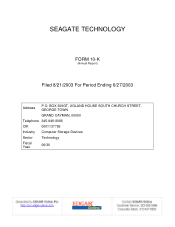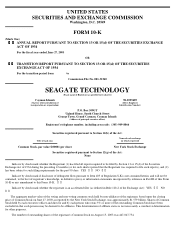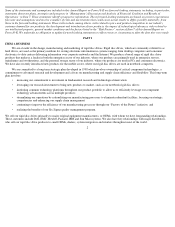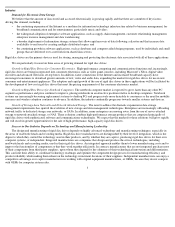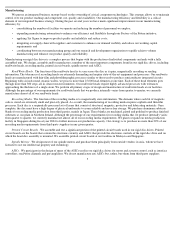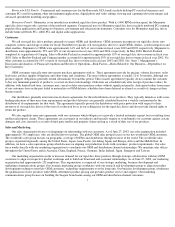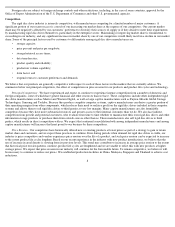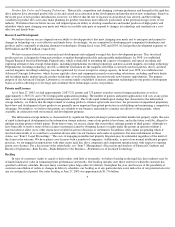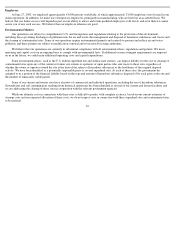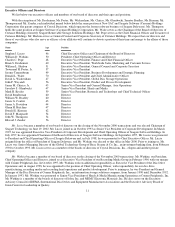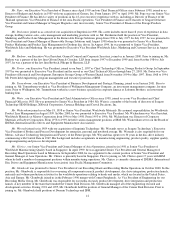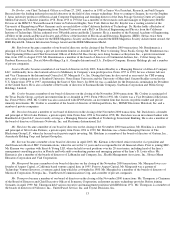Seagate 2002 Annual Report Download - page 6
Download and view the complete annual report
Please find page 6 of the 2002 Seagate annual report below. You can navigate through the pages in the report by either clicking on the pages listed below, or by using the keyword search tool below to find specific information within the annual report.
Due to the significant challenges posed by the need to continually innovate and improve manufacturing efficiency, the rigid disc drive
industry continues to undergo significant consolidation as manufacturers and merchant component suppliers merge with other companies or
exit the industry. For instance, IBM recently combined its rigid disc drive business with that of Hitachi. Consolidation is likely to continue in
our industry as the technological challenges and the associated levels of required investment grow, increasing the competitive necessity of
large-scale operations. We believe the competitive dynamics of the rigid disc drive industry favor integrated, independent manufacturers with
the scale to make substantial technology investments and apply them across a broad product portfolio and set of customers.
Overview of Rigid Disc Drive Technology
All rigid disc drives incorporate the same basic technology although individual products vary. One or more rigid discs are attached to a
spindle assembly powered by a spindle motor that rotates the discs at a high constant speed around a hub. The discs, or recording media, are the
components on which data is stored and from which it is retrieved. Each disc typically consists of a substrate of finely machined aluminum or
glass with a layer of a thin-
film magnetic material. Read/write heads, mounted on an arm assembly similar in concept to that of a record player,
fly extremely close to each disc surface and record data on and retrieve it from concentric tracks in the magnetic layers of the rotating discs.
The read/write heads are mounted vertically on an e-shaped assembly. The e-block and the recording media are mounted inside a metal casing,
called the base casting.
Upon instructions from the drive’s electronic circuitry, a head positioning mechanism, or actuator, guides the heads to the selected track
of a disc where the data is recorded or retrieved. Application specific integrated circuits, or ASICs, and ancillary electronic control chips are
collectively mounted on printed circuit boards. ASICs move data to and from the read/write head and the internal controller, or interface, which
communicates with the host computer. Rigid disc drive manufacturers typically use one or more of several industry standard interfaces such as
advanced technology architecture, or ATA, small computer system interface, or SCSI, and Fibre Channel. Recently a new standard, Serial
ATA, has been introduced. Serial ATA provides higher data transfer rates than the previous ATA standard.
Rigid disc drive performance is commonly assessed by five key characteristics:
•
storage capacity, commonly expressed in megabytes, gigabytes or terabytes, which is the amount of data that can be stored on the
disc;
•
spindle rotation speed, commonly expressed in revolutions per minute, which has an effect on speed of access to data;
•
interface transfer rate, commonly expressed in megabytes per second, which is the rate at which data moves between the rigid disc
drive and the computer controller;
•
average seek time, commonly expressed in milliseconds, which is the time needed to position the heads over a selected track on the
disc surface; and
Areal density is a measure of storage capacity per square inch on the recording surface of a disc. Current areal densities are sufficient to
meet the requirements of most applications today. We expect, however, the long-term demand for increased drive capacities to continue to
grow as audio and visual data require many multiples of the storage capacity of simple text. We have pursued, and expect to continue to pursue,
a range of technologies to increase areal densities across the entire range of our products to increase drive capacities and to allow the
elimination of components at a stated capacity as areal density increases, thus reducing costs.
4
•
media data transfer rate, commonly expressed in megabytes per second, which is the rate at which data is transferred to and from the
disc.

